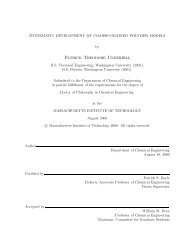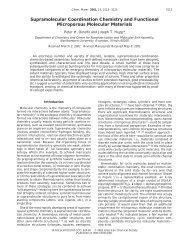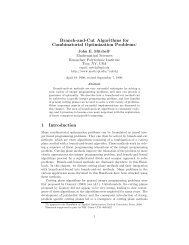Enhanced ultraviolet sensitivity of zinc oxide nanoparticle ...
Enhanced ultraviolet sensitivity of zinc oxide nanoparticle ...
Enhanced ultraviolet sensitivity of zinc oxide nanoparticle ...
You also want an ePaper? Increase the reach of your titles
YUMPU automatically turns print PDFs into web optimized ePapers that Google loves.
362 L. Qin et al. / Optical Materials 33 (2011) 359–362<br />
been achieved. The ratios <strong>of</strong> UV photo-generated current to dark<br />
current (on/<strong>of</strong>f ratio) are shown in Fig. 6. In uncoated ZnO <strong>nanoparticle</strong>s<br />
(ZnO–A), the ratio is about 9 10 3 when the bias is 20 V.<br />
Meanwhile, for PVA coated ZnO <strong>nanoparticle</strong>s (ZnO–U) the ratio<br />
is as high as 4.5 10 4 , 5 times that <strong>of</strong> uncoated ZnO <strong>nanoparticle</strong>s<br />
(ZnO–A). Since most <strong>of</strong> the UV-generated carriers in the ZnO are<br />
trapped by defects during transportation to the terminals and uncoated<br />
ZnO <strong>nanoparticle</strong>s (ZnO–A) has a higher surface defect concentration<br />
than PVA coated ZnO <strong>nanoparticle</strong>s (ZnO–U), this<br />
increased ratio is expected. However, the dark currents <strong>of</strong> both<br />
detectors are about 100pA at 20 V bias. This indicates PVA does<br />
not change the conductivity <strong>of</strong> ZnO <strong>nanoparticle</strong>s, but acts as an<br />
effective surface passivation material to improve the photo<strong>sensitivity</strong><br />
<strong>of</strong> ZnO <strong>nanoparticle</strong>s. The charge transport mechanism<br />
across the ZnO/PVA/Al is still under investigation. However, it is<br />
speculated that it could be due to tunnelling.<br />
4. Conclusion<br />
In conclusion, enhanced UV emission and suppression <strong>of</strong> parasitic<br />
green photoluminescence has been observed in PVA coated<br />
ZnO <strong>nanoparticle</strong>s prepared using a top-down wet-chemical etching<br />
process. Photoconductor based on PVA coated ZnO exhibited<br />
increase in photocurrent <strong>sensitivity</strong>. These results indicate that<br />
PVA coating <strong>of</strong> ZnO <strong>nanoparticle</strong>s could be applied in creating<br />
low cost, sensitive and visible blind UV photodetectors.<br />
Acknowledgements<br />
The authors gratefully acknowledge support from National<br />
Security Technologies through NSF Industry/University Cooperative<br />
Research Center Connection One. The authors also acknowl-<br />
edge the National Science Foundation Smart Lighting Engineering<br />
Research Center (EEC-0812056).<br />
References<br />
[1] J. Sheu, M. Lee, C. Tun, S. Lin, Appl. Phys. Lett. 88 (2006) 043506.<br />
[2] P. Durán, F. Capel, J. Tartaj, C. Moure, Adv. Mater. 14 (2002) 137.<br />
[3] D. Lin, H. Wu, W. Zhang, He. Li, W. Pan, Appl. Phys. Lett. 94 (2009) 172103.<br />
[4] E. Neshataeva, T. Kümmell, G. Bacher, A. Ebbers, Appl. Phys. Lett. 94 (2009)<br />
091115.<br />
[5] S. Lee, Y. Jeong, S. Jeong, J. Lee, M. Jeon, J. Moon, Superlatt. Microstruc. 44<br />
(2008) 761.<br />
[6] M. Wang, Y. Lian, X. Wang, Curr. Appl. Phys. 9 (2009) 189.<br />
[7] X. Zhua, I. Yurib, X. Gana, I. Suzukib, G. Lia, Biosens. Bioelectron. 22 (2007)<br />
1600.<br />
[8] Y. Qin, X. Wang, Z. Wang, Nature 451 (2008) 809.<br />
[9] Y. Jin, J. Wang, B. Sun, J. Blakesley, N. Greenham, Nano Lett. 8 (2008) 1649.<br />
[10] Y. Lin, C. Chen, W. Yen, W. Su, C. Ku, J. Wu, Appl. Phys. Lett. 92 (2008) 233301.<br />
[11] G. Cheng, Z. Li, S. Wang, G. Gong, K. Cheng, X. Jiang, S. Zhou, Z. Du, T. Cui, G.<br />
Zou, Appl. Phys. Lett. 93 (2008) 123103.<br />
[12] J. Jun, H. Seong, K. Cho, B. Moon, S. Kim, Ceram. Int. 35 (2009) 2797.<br />
[13] S. Monticone, R. Tufeu, A. Kanaev, J. Phys. Chem. B 102 (1998) 2854.<br />
[14] Y. Wu, A. Tok, F. Boey, X. Zeng, X. Zhang, Appl. Surf. Sci. 253 (2007) 5473.<br />
[15] L. Wu, Y. Wu, X. Pan, F. Kong, Opt. Mater. 28 (2006) 418.<br />
[16] S. Sharma, A. Tran, O. Nalamasu, P. Dutta, J. Electron. Mater. 35 (2006) 1237.<br />
[17] Z. Bi, J. Zhang, X. Bian, D. Wang, X. Zhang, W. Zhang, Z. Hou, J. Electron. Mater.<br />
37 (2008) 760.<br />
[18] W. Heo, V. Varadarajan, M. Kaufman, K. Kim, D. Norton, F. Ren, P. Fleming,<br />
Appl. Phys. Lett. 81 (2002) 3046.<br />
[19] A. Umar, S. Lee, Y. Lee, K. Nahm, Y. Hahn, J. Cryst. Growth 277 (2005) 479.<br />
[20] Y. Wang, I. Leu, M. Hon, Electrochem. Solid-State Lett. 5 (2002) 53.<br />
[21] K. Borgohain, S. Mahamuni, Semicond. Sci. Technol. 13 (1998) 1154.<br />
[22] D. Talapin, A. Rogach, E. Shevchenko, A. Kornowski, M. Hasse, M. Hasse, H.<br />
Weller, J. Am. Chem. Soc. 124 (2002) 5782.<br />
[23] H. Xiong, Z. Wang, Y. Xia, Adv. Mater. 18 (2006) 748.<br />
[24] L. Guo, S. Yang, C. Yang, P. Yu, J. Wang, W. Ge, G. Wong, Appl. Phys. Lett. 76<br />
(2000) 2901.<br />
[25] S. Mridha, M. Nandi, A. Bhaumik, D. Basak, Nanotechnology 19 (2008) 275705.<br />
[26] S. Venkataprasad Bhat, S.R.C. Vivekchand, A. Govindaraj, C.N.R. Rao, Solid State<br />
Commun. 149 (2009) 510.<br />
[27] V.A. Fonoberov, A.A. Balandin, Appl. Phys. Lett. 85 (2004) 5971 (2004).<br />
[28] V.A. Fonoberov, K.A. Alim, A.A. Balandin, Phys. Rev. B 73 (2006) 165317.







